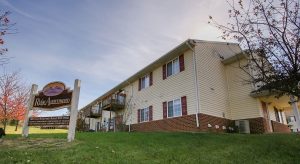RGGI Facts & FAQs

Deerfield Apartments in Crewe; photo credit: project:HOMES
What is RGGI? The Regional Greenhouse Gas Initiative (RGGI) is a regional cap and trade program designed to reduce carbon dioxide emissions from the power sector. Regulated power plants are given allowances for CO2 emissions, which are then auctioned each quarter. In 2020, Virginia became the first southern state to join RGGI. Fifty percent of the state’s proceeds from these quarterly auctions go towards making low-income, affordable housing more energy-efficient.
What energy efficiency programs does RGGI fund? Virginia is the only RGGI state that dedicates fifty percent of its carbon-trading funds to make both new and existing low-income housing more energy-efficient, allowing weatherization providers and affordable housing developers to provide safe, affordable, and energy-efficient homes to low-income families like never before. During the first two years of participation, RGGI provided $250M to make low-income housing in Virginia more energy efficient.
How are RGGI funds administered? The Housing Innovation Energy Efficiency (HIEE) fund, administered by the Department of Housing and Community Development, provides capital to make energy efficiency upgrades to both new and existing housing.
For existing housing, the Weatherization Deferral Repair (WDR) program works in tandem with the federal weatherization program to provide funds for major health and safety repairs- such as new roofs, HVAC replacements, mold remediation, and leak repairs- that would otherwise go unresolved if these funds did not exist. Once a weatherization provider makes the WDR repairs, they can then fully weatherize the home through the federal weatherization program.
“WDR allows us to return to clients who have applied for weatherization but have been deferred for services due to major home repairs needed”, said Bradley Strahm, Business Development Specialist at Community Housing Partners. “These clients do not have the financial resources to make these home repairs, so many have been waiting for several years before they can receive energy-saving weatherization services.”
The Affordable and Special Needs Housing (ASNH) program funds leverage federal and state financing options to ensure more energy-efficient affordable housing comes to market every day. These RGGI dollars administered through the HIEE fund, are provided as forgivable, no-interest loans and are capped at $2M or 10% of construction costs per project. In order to receive these funds, a project must provide additional high performance criteria- above and beyond what is already required for the Low-Income Housing Tax Credit- depending on project type.
“The Affordable and Special Needs Housing dollars from RGGI that were allocated to the projects that Piedmont Housing Alliance is undertaking provide direct investments into the lives of the lower income, working class renters and homeowners who will call these communities home. These families will spend hundreds of dollars less a year on energy costs on average – hundreds of dollars that translates to stable, safe, warm home environments,” said Sunshine Mathon, Executive Director of the Piedmont Housing Alliance.
RGGI dollars are being used in every region of Virginia. From major health and safety repairs on existing housing to the construction of affordable, energy-efficient homes, RGGI dollars are making a major difference and creating high-paying jobs that cannot be outsourced.

Ridge Apartments in Woodstock; photo credit: CHP Energy Solutions
How do these programs make a difference? Low-income households face a disproportionately higher energy burden. Energy burden, as defined by the Department of Energy, is the percentage of gross household income spent on energy costs. Nationally, the energy burden of households not considered low-income is estimated at 3%. According to DOE’s Low-Income Energy Affordability Data (LEAD) Tool the national energy burden average for low-income households is 8.6%, nearly three times higher. In Virginia, some communities average as high as 19%, according to the Virginia Department of Energy. This can mean choosing between paying utility bills, paying rent, or purchasing medicine and groceries.
Inefficient housing is a key factor leading to high energy burdens. In a report on high energy burden, the American Council for an Energy-Efficient Economy highlights weatherization as a long-term strategy to mitigate the effects of high energy burden on low-income families.
Virginia’s participation in RGGI is one such strategy. During the first two years of participation, RGGI provided $250M in revenue for low-income energy efficiency housing programs in Virginia. That’s more than every other energy efficiency program in the state, combined.
How can I help? Share your support of RGGI and the vital energy efficiency programming it provides. In addition to this factsheet and the VAEEC’s official comments, the VAEEC website has a dedicated RGGI page with our public comments, talking points, video series, and case studies on how RGGI dollars are being used to help Virginians across the Commonwealth, as well as links to news coverage for additional resources to help you craft your commentary.
Low-income Virginians can’t afford to have these programs disappear. Thank you for voicing your support for these life-changing programs that provide services to the most vulnerable in our communities.
